BMW Turbos
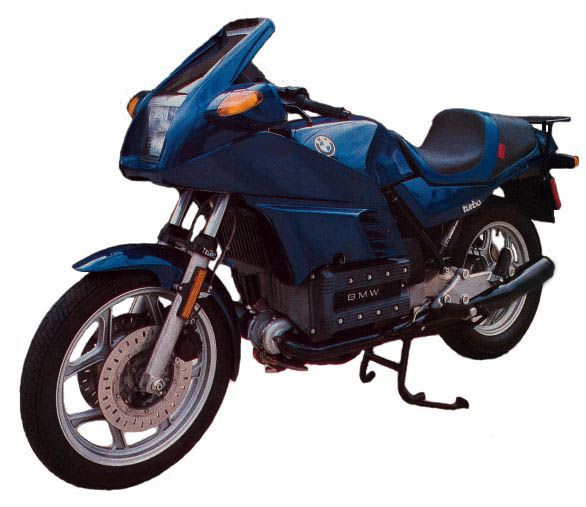
Pictured above is our first generation K100 turbo done more than 20 years ago. Later versions had "split" intercoolers. These were the first of the watercooled BMWs and the worl's first intercooled and fuel injected turbo bikes. With larger turbos the went on to set some speed records both at the strip and in top speed venues like El Mirage and Bonneville. Somewhere around 200 of these were produced. Prior to these we focused on the air cooled R series for which hundreds of kits were made.
Many Years Later
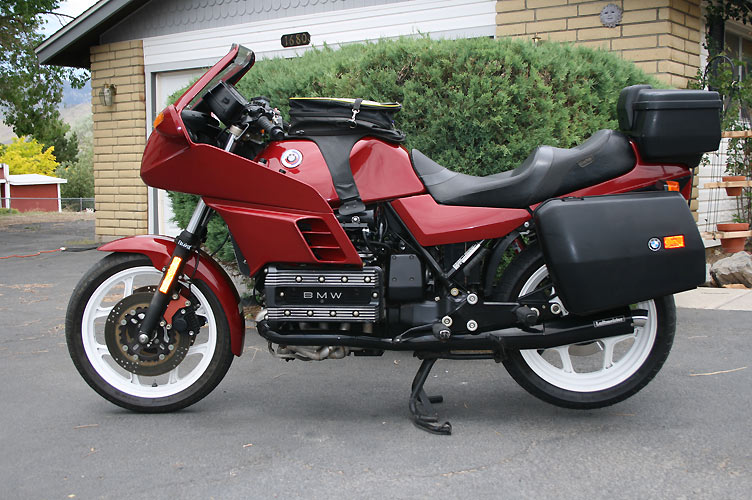
Owner writes: "Dear RB
Racing; I am contacting you about a 85 K100 turbo bike I acquired a few
years ago. I loved it then and love it now. I have done my best to find
out its history just because it is so darn fast. When I acquired it I
thought it was built by Luftmeister. I have done a lot of research on
the bike and now I know the truth. I hate the fact I have Luftmeister
on the exhaust and even on the harness tape. I had no idea you were
behind all the R and D and your company never was acknowledged in 94 at
El Mirage. I have gone over every thing you have done to K bike for
racing, I also read how you took it all back after the runs. So now
here is where I am confused. What do I have; I have seen pictures of
the bike that did the runs parked right next to the R Bike. I really
think that the bike I have is the one that did the runs and if it is
how did it manage to get out. I know if it had all the original K bike
equipment put back on it, the average person really would not even be
able to tell their is a lion under that stock faring. I new when I
purchased it someone had put a lot of money and research to get that
kind of power out of a 998cc bike.
The first day I had it, I made a trip to Reno from Carson. I was going
through Washoe valley and decided to rool it on a little and see how it
ran. I was doing about 70 and drooped down to third gear and rolled on
to the throttle.the boost came on so hard it was kind of a spiritual
feeling. I let her go to 160 or so in fourth gear running close to
10,000 rpm and shifted to fith and let it slow down. The boost was
around 12 lbs.
I have taken the bike on some long rides riding very aggressive with
boost running 3 to 6 lbs for up a couple of hours. I have worn out Metz
4 tires in a few hundred miles. I know Matt had nothing to do with the
build, I would have blown it up long ago.
All in all I just want to thank you and your team and shame on Matt.
Here are a couple of Pics.
I do have questions to ask and I know only you guys would have the
answers; If it is what I think it is,rest assured it will end up at its
rightful home at RB. Thanx Mike"
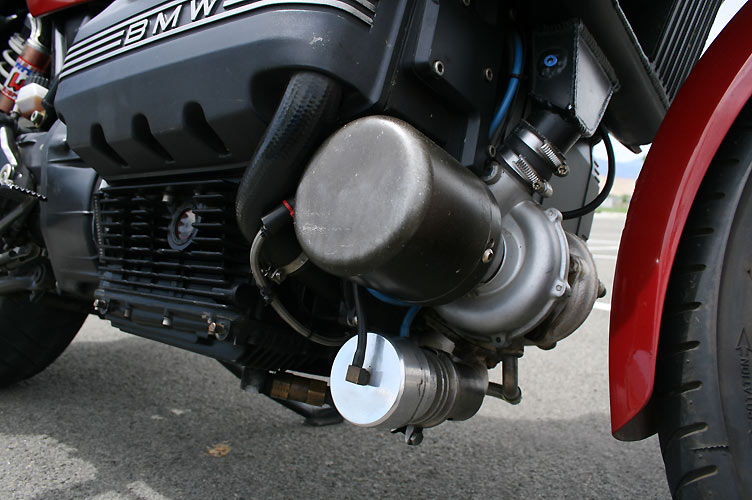
Response from RB
Racing: No it is not the race bike. It is the second generation K100
Turbo. The first generation kits were done with intercoolers that were
not "split" but these blocked the radiator which could cause
overheating in very hot environments. The bike pictured has the split
intercooler.
The inlet air cleaner "can" cover pictured above was done to allow the bike to be run in wet weather. It separated the ingested water from the small air cleaner. It was made for a short while but was very complex to make and little appreciated and since we weren't paid for it so we stopped making them after 20 or so were made.
The race bike had a very large custom nose-mounted intercooler a larger RHB6 Turbo and our RSR fuel injection system. The race bike started out as a stock K100 but was butchered up for race use only rendering it useless for street use and went through three fairings and many changes. In the end we redid the bike at our expense after Luftmeister kept doing more and more stupid modifications....We tested it once, loaded it in the race trailer... and Matt Capri made one 206 mph pass at El Mirage and we removed our electronics as we were never going to get paid for our work. 312 hp.
Kit #003 30 Years later
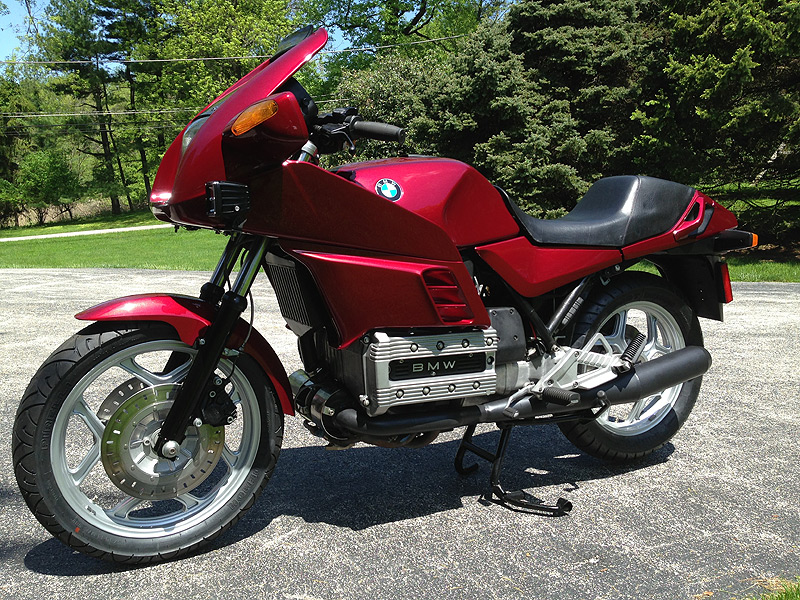
Circa 1985. No split intercooler. Still running. We do not support these. Ancient history.
15 years with Matt Capri or Why the scorpion said “"I'm a scorpion; it's my nature."
The year was 1981 and we were turbocharging Harleys, Hondas, Suzukis and Kawasakis...A phone call came from Matthew A. Capri who asked us if we could turbocharge a BMW air cooled twin. We only knew of Matt who was running Luftmeister as someone who made copies of Vetter Fairings i.e. “Luftmeister” and sold accessories like luggage racks. We checked around and found out Matt had talked American Turbo Pak (long since defunct) out of a prototype R100 Turbo kit they had fabbed up with a way too large Rajay turbocharger and a Bendix-Zenith carburetor. It did not work as it would only boost at high loads and rpms. We were warned to watch our back by several people.
We informed Matt we knew of his previous dealings with ATP and made a couple of handshake deals...We would design two kits, one for a race bike and one for production. They would be sold as “Luftmeister” and RB Racing would stay out of the picture save the design and production side of the equation.
The Race kit went on Rob North framed R100 monoshock and the production kit went on a standard R100, the race version with an IHI RHB6 turbo, and the production version with a small IHI RH05 turbo. The production version had to be purchased in quantities at a price we would set and the Race Turbo would be used for promotion and drag racing at no charge to Luftmeister unless it was sold. The race kit ran one 10 second quarter mile and was retired. The production R100 kits went into production with Luftmeister buying the IHI turbos, handling the carburetion with a Keihin snowmobile unit and, finally, packaging of the components. Several hundred were sold.
We specifically made the deal that Luftmeister keep RB Racing’s name out of the picture. As long as we got paid it was in our interest not to be associated with Matt’s dealings.
The cost of the components to include the turbo and specific turbocharger plumbing on the Race Turbo were $1,100.00 not including and labor or finishing costs. A handshake deal was that RB Racing was to be repaid the $1,100.00 component cost if the race kit was sold. We found out much later that Matt had sold the parts to Fred Wiley of Big Twin in Boise Idaho. We went to collect our $1,100.00 only to be told by Matt that “as he recollected...he was only to pay us if he sold the bike and since the bike was in his garage at home he wasn’t going to pay us”. Either small claims court or go back and jack up the prices for anything he bought from us. We jacked up the prices. He passed them on.
Matt asked us to copy a 2 into 1 R100 exhaust he had borrowed from a vendor, Alphabet if we remember correctly, and we refused. We ended up designing a better 2-1 exhaust for the R100‘s and R65 models and, later on, exhausts for both 3 and 4 cylinder K series BMWs. Matt made two attempts to have our exhausts copied to “cut us out”. Both times we found out about it and simply showed him a newer design we kept in the wings and then doubled his price for the annoyance. Anyone can copy something. It’s quite a different matter to keep coming up with new items. We always kept the “next big thing” under wraps. We always do.
The 1985 arrival of the watercooled K100’s killed the airhead turbo market and we designed a 5 psi RHB52 IHI turbo kit for the new K100RS. The Bosch mass sensing LE Jetronic and it’s four fuel injectors, which totaled only about 50 lbs/hr was only good for about 100hp with the turbo. An honest 100 hp was enough to outrun a Z-1 Kawasaki at the time. It was the first fuel injected, intercooled, motorcycle turbo in the world. Giving a K100 another 30+ horsepower was a pretty big deal.
In August of 1985 RB Racing went to the Bonneville Salt Flats with a couple of Suzukis and a Harley Shovelhead and there was Motorrad of St Louis with a K100 Turbo sidecar with an incredibly crude turbo designed by Reeves Callaway. Since the kit we had just designed was extremely elegant we were patting ourselves on the back until we found Reeves had charged $15,000.00 and we had just done our excellent work gratis. Reeves had to use an electric diaphragm pump to scavenge the turbo oil whereas we had perfected and internal scavenge routed through the oil pan. Being clever and smart doesn’t always pay the bills. Reeves got out of the “kit” business early on and moved on to Chevrolets.
Luftmeister began selling the K100 kits and we made two changes: (1) An incredibly complex stainless steel header or exhaust manifold replaced the mild steel one and (2)the intercooler was split in the middle to allow more air to get to the radiator as K100 cooling was marginal in hot weather.
Matt complicated matters by trying to raise the K100 boost levels when the stock system would only support 100hp....Four 12.5 lb/hr injectors. You do the math. His solution was to get a rising rate fuel pressure regulator from Corky Bell and ask us to copy it. Since it was an insanely stupid idea in the first place we declined. With about 8 square inches of diaphragm it causes fuel pressure to rise exponentially with boost which has two consequences: (1) The fuel pressure can only be correct at one intersect, not before or after and (2) The stock fuel pump and the injectors were not designed for exponential pressures. Matt attempted to race a K100 in this format with him twiddling an aquarium bleed off valve as the fuel pressure rose off the charts to 130 psi.... Destroyed parts, just don’t tell the customers about it.
We countered with a 5th injector set up that allowed the boost to be raised to 125 hp levels and subsequently made an eight injector setup controlled by our RSR AIC400 Additional Injector Controller that took the horsepower up to 180 @ 15 psi. After making a few of these we found out that Matt had contracted an ex-employee of MSD Ignitions to make a pseudo copy of our RSR AIC400. Fortunately, or unfortunately, all the copies failed and that put an end to to the AIC business at Luftmeister.
Desperate to set some speed record Matt went Bonneville with a K100 and a K75 and failed. ..still twiddling aquarium valves and rising rate regulators. Total failures. Next was to get involved with Mike Corbin (Corbin) and later on with Charley Perethian (Parabellum) trying to get free custom made K100 race fairings from both. More disasters, this time at El Mirage. No records. Blown engines. Evil handling with poorly designed fairings the rider could not see out of. New grand ideas about sleeving K100’s, putting in longer rods and putting in “big bore kits”. Never mind that there is no room between the bores for this and it was another grand idea that never should have come up in the first place. We washed our hands...our name wasn’t there, but it sure wasn’t going anywhere but down.
We told Matt the oem K100 fuel pump was not suitable for high horsepower and his solution was to put on a second pump in series after the oem in-tank pump. That does not work and is beyond stupid, especially when you get the bright idea to wire the pump in with some thin gauge aluminum wire you had laying around. Poof!
We finally got fed up with all the failures, which Matt always proclaimed to the world to be supreme successes with “ unbelievable power”. His mantra was “if you don’t blow up your stuff you aren’t trying hard enough”. Of course you are supposed to accomplish something which he hadn’t. We had him get rid of any “helpers” and had him strip his K100 to ground zero, get rid of all the crap he and others had added, repair the engine, and we would build a new race turbo setup with:
A larger turbo.
A special stainless race only header (took 5 days to make).
A twice as large intercooler.
Our RSR EFI Closed Loop 8 injector system with a custom plenum chamber.
Our programming.
And,of course, one large fuel pump.
We made one completely illegal 130 mph test of the bike on Long Beach streets, blowing two red lights, told Matt to load it up, without him having ridden it, for the SCTA El Mirage meet. First pass... 206 mph and a record. 309 hp from 980cc.
We then removed our equipment from the K100 as we had proved our point and we had long since learned we would never be paid for it.
We moved on. After not getting paid for a R1100RS turbo kit, back in the 1993-1994 time, we waited more than a decade to design a new one. Then there was the Triumph Daytona Turbo system we ended up losing a lot of money on. As Luftmeister imploded as a business we went to a “If you show up with cash we might do something” mode. On the way out the door of our business Matt grabbed a motorcycle helmet he had given us six months earlier as a present for a younger rider...saying, "You aren't using this right now and I can sell it". Never saw him again. Don’t want to. He left a trail of destruction.
Matt had picture of himself standing by the El Mirage 206 mph record setting K100 and told us people needed “heroes” and that he was one. Not for us. We gave him all the rope we had...from 1981 to 1995. As the scorpion said in the fable as the turtle asked him why he has stung him...”It’s in my nature”.
BMW K1200RS Water Injection Systems
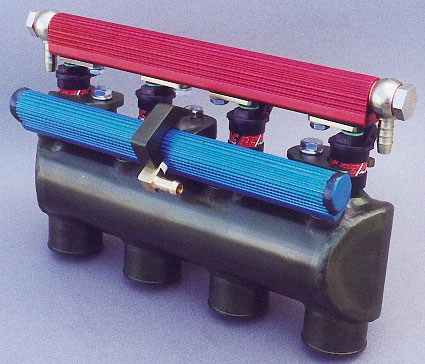
We have posted detailed information on our new RSR Water Injection systems for the K1200 series as well as for other BMW Turbos . Check out our new calculator that we use to design your water injection system.
New Bosch Billet Fuel Regulators
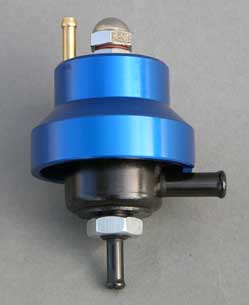
For 2005 we have improved our fuel regulators by using a Bosch Billet Adjustable Regulator. We use these in all our fuel system upgrades as well as with our turbocharger systems. More precise and better seats with a hardened and ground ball and socket design. Holds pressure better for smoother operation and more reliable low battery condition starting.
Part Number 06-1023 $195.00. Comes with 12mm x 1.5 jam nut for mounting.
Boost Gauge

3 Bar Boost Gauge with Tattle-Tale indicator showing maximum boost actually run. Glycerin filled to resist vibration. Comes with stainless steel handlebar mount. Easy to reset, even with gloved hand.
Part Number 03-1013 $149.50. Center back mount w/12mm x 1.5 locknut and integral push-on hose nipple.
Watch the Grinnall Video
RB Racing designed and produced Turbochargers for BMW motorcycles for over 15 years encompassing kits for both air cooled twins as well as inline 3's and 4's (R100/K75/K100/K1000/K1100) as well as the newer R1100RS models. The bikes were used for daily commuting, racing, dyno contests, and for all we know coffee tables. We know of K100 bikes that went over 80,000 miles with turbochargers tucked under their chins.
My touring bike can beat your sport bike
The first and only BMW ever to exceed 200 mph was turbocharged by RB Racing and used an RSR Closed Loop Fuel Injection system with 8 injectors. RB Racing turbos were the first BMWs into both the 10's and 9's at the drag strip. They were also the world's first fuel injected and intercooled bikes in 1985 with the debut of the new K-bikes. There probably isn't anything funnier than a K bike with saddle bags running ten second quarter miles at over 130mph! Dyno contests promptly shut down when K bikes hit 180+ rear wheel horsepower...the ZX-11s went home to find leaf blowers for their ram-air systems.
Black leather, Black streaks
Sport Rider tested an R1100RS and with only two passes ran a 10.64 second 130.80 quarter mile with 12psi boost on 92 octane unleaded pump gasoline. Journalists Joe Haile and Paul Peczon both proclaimed the R1100 Turbo to be flawless in its power delivery and civility. The R1100RS used an RSR AIC400 Additional Injector Controller to provide the additional fueling.
Initial tests at El Mirage put a dead stock K1100RS through the traps at 194mph with only 8 pounds of boost.
Multiple 200 mph records were set on 2 valve K100's which were putting out 312hp in full race trim. In case you are wondering, no they weren't your average street kits...they had bigger turbos, bigger intercoolers, RSR Fuel Injection and of course, bigger gears.
Click on photo to enlarge__________________206.100 mph El Mirage Dry Lakes Record
Show Me The Horsepower
We know they are well made and they have driveshafts. We also know BMW car owners always say "I didn't know BMW made motorcycles!". What you don't get to show anyone is a lot of horsepower and your diasppearing license plate because 70hp K100s and 90hp R11s and K1100s aren't going to warp drive when you twist your wrist. People ask us how much power the turbos produce and we always tell them it depends on how big the turbo is and how much boost you are running. Here's some figures to ponder: R1100 225hp @ 22 psi; K100 180hp @ 15 psi (street); K100/K1100 (Race) 275hp @ 18 psi. We use different turbos with different size compressors, exhaust housings and fuel control strategies depending on what you want to do. No one said it was easy, but we have 20 years of experience that guarantees you will go turbo and stay turbo.
The Ugly_____
All kits are currently under revision due to the business failure of the BMW distributor formerly known as Luftmeister, Inc. We spent an inordinate amount of time and effort on their behalf and finally gave up when they collapsed, taking a lot of people with them. It's funny how people can screw up a deal when they're handed a "done deal". It's even funnier when they think what you do is "easy" even though they've never done it. BMWs do not deserve half-ass, misguided, uninformed treatment.
Polish your propeller, there's hope
BMW's remain perhaps the toughest motorcycle engines alive due to BMW's philosophy of overbuilding components then detuning the motors. Nikasil liners, Mahle pistons, dry automotive clutches and splendid cooling make them ideal turbo candidates. Probably the worst thing you could do would be to "build" the motor as they aren't set up to be bored / stroked etc. Changes in camshafts and cylinder head work will always benefit a turbo as the engine is nothing more than a glorified air pump and anything you can do to help it breathe will benefit a turbo motor.
Turbo systems are now being built on a custom basis to your exact specifications depending on the options and intended usage. Contact RB Racing for initiating your custom order for your particular BMW motorcycle.
Kits are fully developed for K100RS/RT, K1000, K1100RS, R1100RS models. Earlier R100 and the newer R1100 models require fit and installation at RB Racing...K1200RS/LT (180 / 275hp) models are available (see below). Bonded and insured shipping to and from RB Racing is available. Contact RB Racing for details.
Expansion
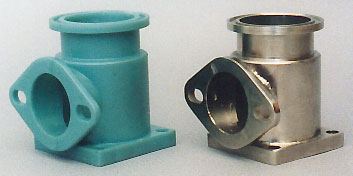
RB Racing has opened a second large R&D facility for prototyping, installations and development. No phones, no TV's, no lookie-loos, to interrupt progress. One radio for mind-numbing motivational background noise. Custom installations of turbo systems, engines, and advanced product development can proceed in a more relaxed atmosphere. Interesting developments are in the works. Pure stealth. No numbers, no names, no windows, no photos. Pictured on the left above is the new wax pattern for our one-piece stainless steel BoostMaster wastegate valve body. Pictured below are the finished castings ready for machining.
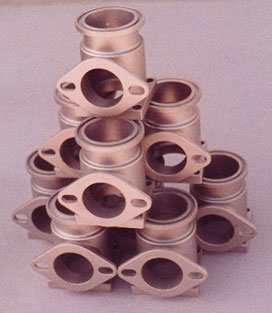
New Shipment of Custom BMW Intercoolers

These are the cores that we used on our first intercooled BMWs back in 1985. Unfortunately when we checked on their availability earlier in the year no one made this particular size anymore, so we had to have a custom run of them made. It was a long wait but it means we can start production of the R and K series turbos once again. The models that we had not done like the later K1200RS/LT models with the Telelever suspension have been schedule for prototyping. Kit prices for the various kits range from US$3,995.00 to $4,500.00 to $6,000.00 depending on options , number of additional injectors etc. R1100/1200 series use two additional injectors. K100 series use either 1 or 4 additional injectors. K1/K1100/K1200 series use 4 additional injectors. All additional fueling is controlled by our AIC400 additional injector controllers. All kits, except the K1200RS / LT are intercooled. All kits feature positive oil scavenge systems and sophisticated inlet breather/blow-off valves.
We've been at this over 20 years and eveyone wants to talk about boost when it comes to turbos. We are engine people and we know it takes more or less160 cfm per 100 hp so we pay attention to the pumping of the air, not the "boost". If your stock K1200RS has 130 hp at the crank it makes no sense to put on a turbo that can't move that much air at low pressure ratios to feed the engine. People confuse boost with airflow. If you have a small turbo you're going to have to run a higher pressure ratio to get the same airflow as a larger unit...and you're going to have to go to more restrictive (smaller A/R) housing to move this air sooner. The result of this will be excessive backpressure and "crossover" where the exhaust pressure excedes the inlet pressure. We use turbos to increase torque where you need it, at the lower rpms without having to run much "boost". There is virtually no need for you to run more than 5 to 8 psi for 99% of whatever you use the bike for. Oh sure, we know you have to turn it up to see what it will do and find out what 250hp feels like...that's what the water injection is for. Even at those power levels the system is blindingly efficient. Just remember, we have engineered a system that at 8 psi moves 200 hp worth of air into your motor. Leave the wastegate set at 5 psi and turn it up when the need arises...or leave it set at 8 psi and simply short shift and let the additional torque do it's job. By 8 psi the turbo delivers 80% of the airflow it delivers at 15 psi! If you don't think turbos are torque monsters you haven't seen the Audi R8 Le Mans prototypes.
If you want to enjoy some history we suggest you purchase the three volume set of Smokey Yunick's chronicles of his long racing career and life. There aren't may original thinkers around and most of them don't do a damn thing. Smokey was different and a genuine legend in American motorsport history. If you just happened on the scene we suggest you buy his books. It's the most entertaining and best investment you'll ever make. Smokey pulled 1000hp out of a destroked 200 cubic inch Chevy at Indy over 30 years ago. If you like technical matters and a bit of history these are the books to buy. Engines, whether they are small block Chevrolets or Bavarian twins all sing the same song.
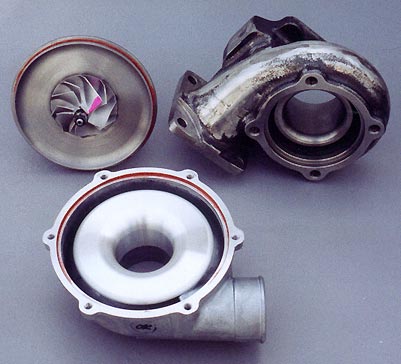
We get asked all the time about what should be done to prepare your BMW for turbocharging...Well, this depends on what your goals are. Before we get into this we should give you a brief rundown on what you already have. If your bike was a Honda it would be superbly engineered and every part would be optimized for performance and reliability at the oem designed rated horsepower...double that figure and the rods, clutches and pistons are past their limits. BMW does things a bit differently. They build it to run for 300 hours non stop at 2.5 to 3 times the rated horsepower, then they cut things by 2/3 and sell it to you. The rods, pistons, cranks and base engine drivetrains are overly engineered on most of the models. The exception to this is the early air cooled models which started out as low horsepower, low rpm engines that weren't tested at 150 to 200 hp. Early K100's are practically bulletproof as they start out with 70 hp and at 125hp turbocharged they will run forever. We pumped them out to 312hp and never had a crankshaft problem although at rpms approaching 12000 they would float their valves and break camshafts.
Equal Fuel Distribution
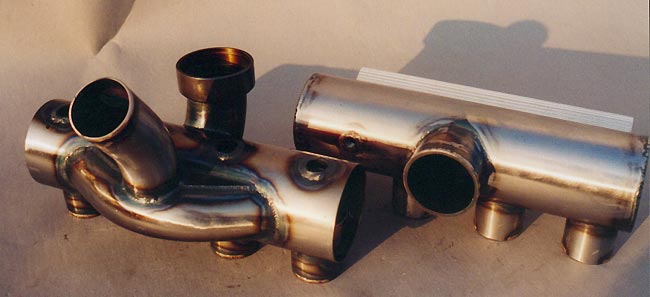
Pictured on the left is a Grinnall inlet plenum for a Motonic series injection system. To the right is an inlet plenum for a K100 LE Jetronic system. Both feature four additional injectors controlled by our RSR AIC400. Semi-finished, prior to polishing and chroming.
In the case of the K100 turbo we employ four additional injectors that are matched to the horsepower potential of our custom turbos. Whether you plan to run 5, 8, or 15...or even 22 psi we have you covered. This is the only way to insure perfect fuel distribution. At the time you order you turbo kit we ask that you send us your oem injectors for cleaning and balancing. In the case of the K100's we stay with the oem stock injectors. For the K12 series we have injector upgrades that improve driveability and provide better and safer performance.
All inlet plenums feature integral velocity stacks and individual port injector for all fuel enrichment.
Pans That Suck
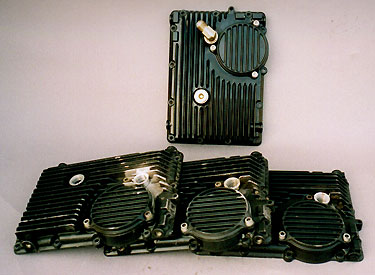
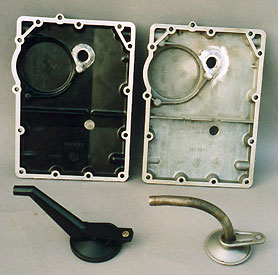
Customer pans sent to RB Racing for oil scavenge modifications featuring o-ring boss AN8 fittings for AN8 stainless steel braided lines. Positive oil scavenging "dry-sumps" your turbo, leaving no residual oil in the drain line. No matter what the circumstances i.e. shut-off, heavy braking, full boost acceleration or high G cornering loads, the turbo will drain properly. There won't be any tell-tale blue smoke foretelling of turbo bearing demise or "coking" of the oil resulting in spun exhaust shaft seals. The two pans on the right were born 17 years apart...the black one from a 2002 K1200RS and the other from a 1985 K100RS. BMW sure is getting some mileage out of that tooling. Along the way the oil pickups went from steel to plastic...the German metal workers must love extrusion machinery. When you go turbo on your K bike, you have to send us your pan with the filter cover in place. If you have the metal pickup send it also. We spent over two months in 2001 revising our oil scavenge system so we are intimately familiar with 5mm Allen wrenches and the feel of BMW oil.
All of your BMWs employ Mahle pressure cast pistons that have excellent oil control and tightly controlled expansion with shapes designed to go 200,000 miles with little fanfare. Unless you are racing and want to go to a forged piston that will deform before it will break, you would be crazy to take out the Mahle pistons. The slipper style pistons on the late model "oilheads" are particularly pretty. They look like a 962 Porsche piston.
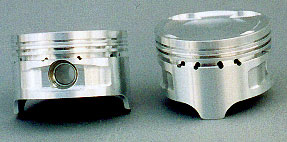
The exception to this rule, and there are always exceptions to rules, is the late model K11/K12 series which are more highly stressed. Early K100's were rated at about 70 horsepower whereas the K1200RS is at 130hp. The engines are very similar in architecture and we can tell you that lower compression forged pistons are necesssary on these bikes. We are designing pistons for all the newer models, both K and R series, to include the older K100's. No, we didn't make 312hp and go 206mph with the stock pistons.
All late model BMWs, including the later series of air cooled R bikes employ Nikasil lined cylinders. These are Formula One items as they provide the best heat transfer as well as wear and oil control parameters. Even in NASCAR which mandates iron blocks all the teams have gone to coatings on the iron cylinders...that should tell you something. Nikasil provides the best surface and heat equation for turbocharging.
Windage, or internal oil control relative to the crankshaft is an area often forgotten. Oil will wrap itself around your crank and kill your horsepower. Late model BMWs although they are wet sump designs get a bit tricky in this regard by keeping the sump below the crank, thus cutting down on windage losses. Oh, they still don't give you and oversquare engine with a 90mm bore that will rev to 18,000 rpm, but you can dream.
Power is what this is all about. In general all the RB Racing turbo kits are designed to give about a 50% increase in power at 8 psi of manifold pressure. At this level they will run forever although at 8 psi you accelerate quite quickly and you don't stay in any gear too long and run out of gearing quickly. We tell customers to turn their Dial A Boost pneumatic controllers to 8 psi and short shift through the gears for normal operation, Turning the controller "off" will let the wastegate go to its minimum setting of 5 psi, which will remind you that the turbo is there. Check out our K1200RS video to see what 5 psi of acceleration will do for you.
Higher boost levels: Everyone wants to go hunting now and again. To those of you who cannot resist the lure of dialing up the power as you ride we offer the following advice. All RB Racing turbo kits can be briefly run to 12 to 15 psi of boost on pump gas...although we caution you that 12 psi is the limit we recommend. For excursions in the 15 to 22 psi range we suggest increasing the octane via racing gasoline, colder spark plugs like NGK Racing plugs, and careful attention to engine temperatures. Your cooling system will not sustain 250+ horsepower very long. We held a K100 on a Superflow Dyno for 2 1/2 minutes @ 15 psi (275 hp) and blew the coolant right out of the oveflow tank! There is no free lunch in this game. When we went for records we chilled the intercoolers, ran blower gas and racing spark plugs.
Click on the title above to go to our RSR Boost Compression Ratio Calculator. This allows you to run scenarios of how boost affects your effective compression ratio as modified by altitude considerations. It will give you a good idea as to why turbos go so fast and also how to plan your motor for your particular circumstances. Knowledge is power.
If
you know the specifications on your motor, such as the K1200RS
described below, you can see what the effects of bore, stroke, static
compression, rod length, cam timing, boost, and altitude are on your
motor. Although you may not be able to change some of the variables,
you will at least be able to see how they interact and how you can use
this information to your advantage. Knowledge is power. Pictured above
are our new K1200 series forged turbo pistons that come with an
improved ring set and special wrist pins. The piston are sold in sets
and are 7% lighter than the stock components. The picture on the right
shows the 2mm pins you need to "pin" the second ring into the "up"
position. For more info on this go to our K1200 Tech Page. ![]()
When you strip off the bodywork you are greeted by what is perhaps the most tightly packaged, complicated, collection of castings, forgings and molded plastic you'll ever likely encounter in denuding any modern sportbike. At this point the bike has already been instrumented to measure stock parameters and the fuel sysyem and oil system have been thoroughly modified to accept our Turbo components. Don't look for the turbo because it isn't in it's home yet. Stay tuned as we will be posting additional pictures of the bike being assembled as well as the extensive instrumentation that comes with the package. Capable of more than twice the horsepower of a ZX-12! You might be limited in your final drive ratio but you will get there faster than anything else you might encounter...and gears can be changed!
12-16-2000: Turbo oil system testing completed with new scavenge system (first major revision since 1985). Scavenge ratios under cold and hot conditions from idle to 9000 rpm have been documented and main system remains unaffected. Four different turbos were tested to find the optimum solution. Zero leaks or capillary bleed down means 100,000 miles plus of trouble free turbo operation. Design work begins on header, turbo, and ancillary components.
First Generation K1200RS Turbo: After, With Bags
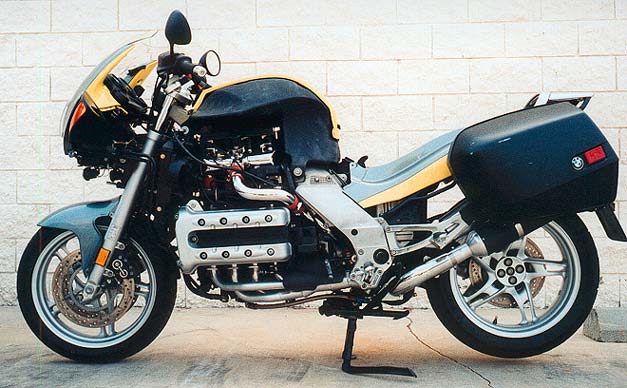
We
designed the turbo muffler portion to have two inches of clearance
between the cannister and the bags...and the final exit extends to the
fender/ license plate. There won't be any cooking of your gear with the
air gaps we have provided. ![]()
First Generation K1200RS Turbo: After, Without Bags
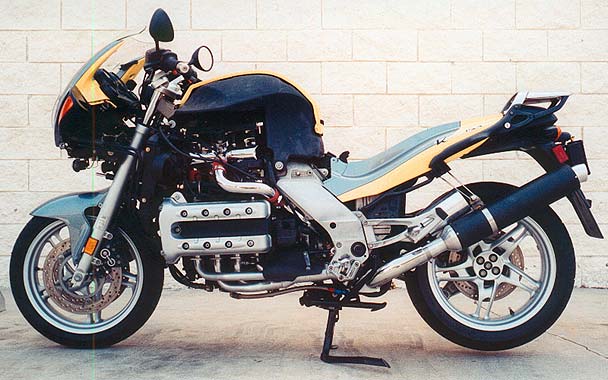
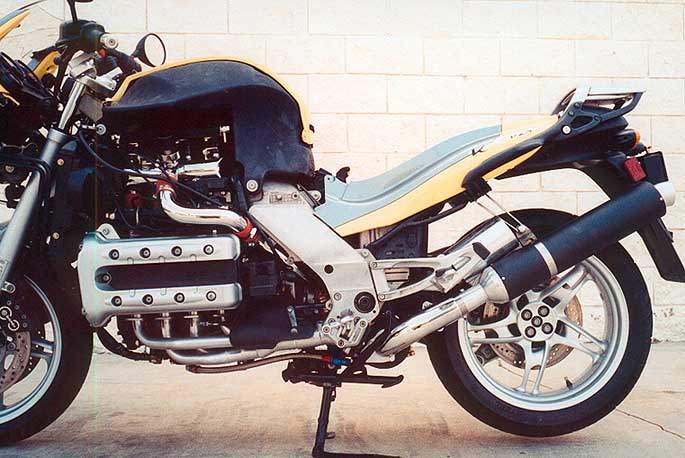
All
major components are in place. No alteration of the stock parts is
necessary except for the oil pan. Oil pans need to be sent to RB Racing
for machining and TIG welding of the oil scavenge port, The braided
stainless AN8 scavenge line is visible beneath the 4-2-1 header. The
EGT (Exhaust Gas Temperature) probe is visible on cylinder number
three. ![]()
On Steroids, Abs no Flab
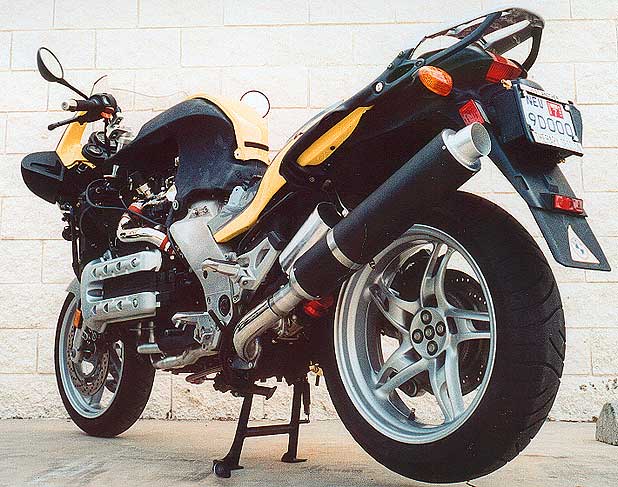
A lot of information if you have a roadmap. Ceramic coated 4-2-1 Header. Red BoostMaster wastegate visible. Black ceramic coated cannister muffler. K&N Air Cleaner cover / splashguard. Silicone coupler hoses on chrome connector pipes leading from turbo to chromed inlet plenum with 4 additional injectors and Inlet Blowoff / Breather valve. At front edge of rear tire is brass valve regulating water injection. Water injection tank, hard anodized black, beneath the license plate. 350hp turbo hidden behind the transmission. Braided oil scavenge line headed back to the oil pan. All this fits under the fairing with no compromises in ground clearance or engine serviceability. Everything long-term corrosion protected. Completely docile day to day operation in a package that moves the K1200 up the food chain.
Bend Over and Cough
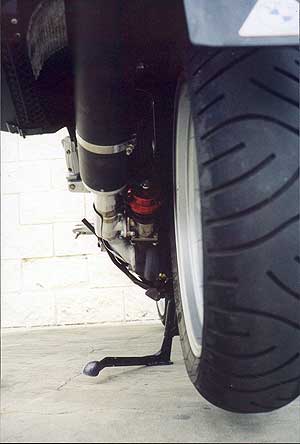
The
turbo kit has no affect on ground clearance. Everything is tucked
inside the "centerstand / sidestand / footpeg envelope" even figuring
in suspension compression. Are those nibs still on the edge of your
tires? Compatible with the optional wider rear rims and tires. ![]()
First Generation Water Injection for K1200 Series
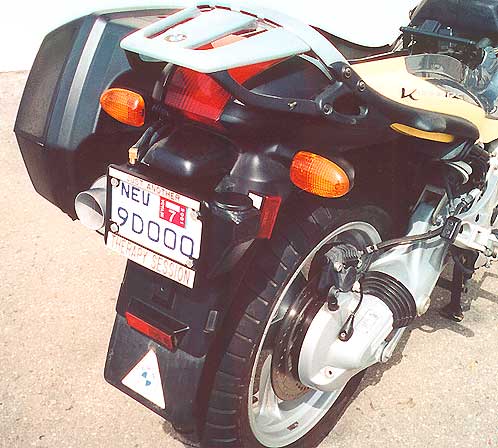
K1200RS
series bikes have about double the hp of the earlier and slightly
smaller K100 series four cylinder machines. Because of this higher
state of tune we need to add a form of detonation control to these
bikes. The hard anodized water tank rests in stealth mode beneath the
license plate with its knurled filler cap easily accessible on the
right. Put in a 50/50 water alcohol mix for those higher boost blitzes.
Does not use any water below 5 psi and very little till you up the
boost past 8 psi. If you have to up the boost with your pneumatic Dial
a Boost controller, the percentage of water injected will scale up
giving you a safe power boost through lowered inlet temperatures. Two
minutes and fifty seconds of 15 psi pressures, which is just long
enough for the long course at Bonneville. Six minutes of water at 8 psi
of boost, which is a long, long time considering the brief time we
spend in boost going through the gears. Just sneaking into boost at 6
psi the tank will provide eight minutes of inlet charge cooling. Get
out your calculators. ![]()
First Generation K1200RS Turbo Kit: The Main Parts
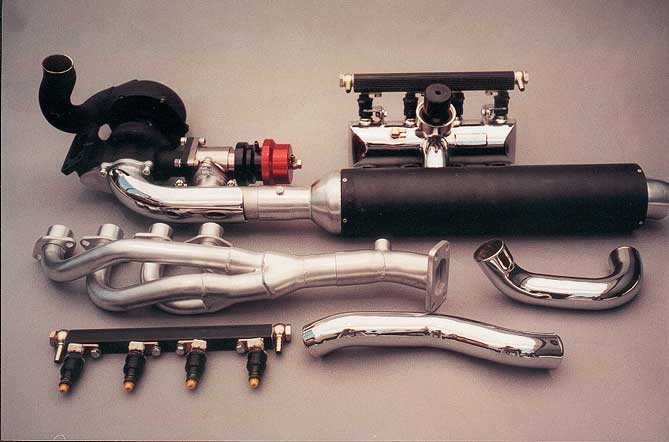
Update
July 2003: Final testing completed, production parts finalized.
Pictured above are earlier parts for the K1200RS Turbo Kit. Newer Items
use a non-riveted cannisted from our new Black Hole exhausts.
Mechanical modifications to the engine's fuel control system have been
completed and tested. OEM primary injector fuel rail replaced by hard
anodized high flow part. Modifications to the Bosch electronics and
final testing of the RSR AIC400 programming to maximum potential (275hp
@ 15 psi) are completed. There are no compromises in ground clearance,
lean angles, fuel economy, or driveability.
Center and side stands are completely unaffected. Oil filter and drain
access are also unaffected. Chrome heat shield on turbo exit. Header
pipes are ceramic coated. Connector pipes from the turbo to the inlet
plenum are chromed, The turbo itself receives a black protective
coating. ![]()
K1200RS Turbo Pod: Red Hat, Black Dress
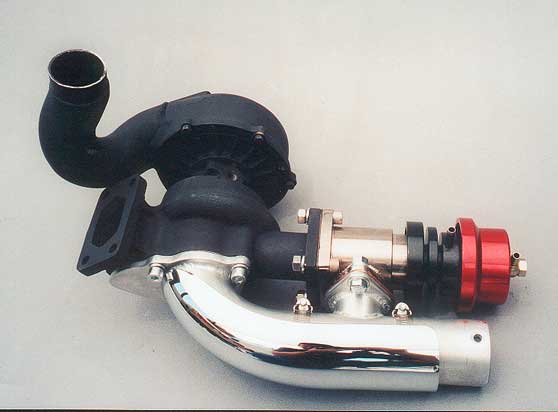
You
know what they used to teach you in Boy Scouts..."Red and Yellow Kill a
Fellow...Red and Black Venom Lack". Well in this case the Coral snake
and this turbo kit are on opposite side of the fence. This Red and
Black Turbo Pod puts out enough air to kill about anything you might
come up against. This is the same turbo we ran 206mph with on a 2 Valve
K100 and the same turbo we used on our Suzuki GSXR1100's that hold
every record at Bonneville and El Mirage (1989 to present). The BoostMaster
wastegate dumps directly into the tailpipe for the ultimate in
sophistication (no wastegate noise). The Turbo Pod is mounted directly
to the frame, independent of the exhaust manifold and tail section. The
exhaust housings are now silver ceramic coated instead of the black
shown above. ![]()
First Generation BMW K1200RS/LT Plenum Chamber
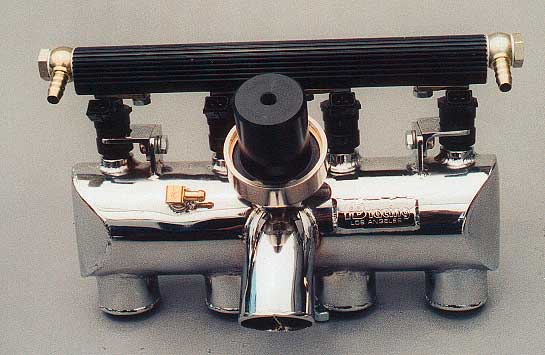
Complicated puppy! BMW sure didn't make our life easy on this one. This is the third and final design that we executed. The first two designs used smaller volume plenums in order to squeeze in a small intercooler but this, in turn, precluded the use of four additional injectors as there was only room for two larger ones. Testing showed we were trying to do too much in too little space so we opted for better breathing and fuel control. The four additional injectors are controlled by the RSR AIC400 Additional Injector Controller which is programmed to meter fuel up to 350hp. The inlet runners have integral radiused velocity stacks to boost torque. The four additional injectors are aimed straight down these velocity stacks Formula 1 style. We felt the larger inlet plenum plus the additional accuracy provided by four injectors (instead of two larger ones) was a better compromise. Our attempts to squeeze in an intercooler were very expensive but in the end the core size would not support the horsepower potential and added additional airflow complications.
In
case you are wondering, the Black Billet Gizmo poised on center stage
is a dual function inlet breather and compressor blow-off valve. Under
vacuum conditions the engine breathes here bypassing the turbo. Under
boost when you close the throttle blades, as when shifting, or just
backing off, the pressure releases here preventing a surge back to the
turbo. This keeps the turbo speeds up and prevents damage to the turbo.
We've been building these in several variations for over 15 years but
like the abominable snowman they have never been seen before. The high
capacity secondary injector fuel rail is hard anodized. To keep things
symmetrical and avoid flow problems we also supply a hard anodized high
capacity fuel rail for your stock injectors. ![]()
Second Generation BMW K1200RS/LT Plenum Chamber

The
development continues. High output testing validated the need for
sophisticated water injection. Running 15 to 18 psi and 255 to 275
horsepower there is no free lunch. We always ran water injection on our
200 mph street bikes...the first street bikes and certainly the first
BMWs to go over 200 mph. The problem with water injection is that water
is nasty stuff to keep around. Three months of intense R&D and we
have a long term sophisticated water injection that you can use on a
daily basis. This is something we are designing into all of our BMW
turbo kits. ![]()
And you thought Carroll Shelby had all the Snakes!

Black
mambas, king cobras, have nothing on this piece of sculpture! BMW did
not want this K1200RS turbocharged! We were absolutely determined to do
it anyway and this is the result. The turbo has a special corrosion
resistant coating so the elements won't eat it up. The inlet system is
sealed and has a 300+ hp K&N filter (housing removed to see the
filter). All this serpentine meandering requires a pile of production
fixtures the size of the bike itself...but the result is a completely
functional turbo system that does not intrude on the rider in any
manner, nor does it require any major surgery or nasty compromises. ![]()
Newest parts move the air cleaner assembly to the right side of the bike and the turbo receives a silver ceramic coating.
Turbo Header K1200RS/LT

Four
into two into one configuration. Ceramic coated inside and out to
prevent heat losses and for long term durability. OEM four wire oxygen
sensor for closed loop operation is retained. We built three variations
of this header and this was the winner. It provided the best compromise
between surface area versus velocity versus broad band power delivery.
The protrusion on cylinder number three is the port for the Type K
Thermocouple that provides inputs to the EGT (exhaust gas temperature)
gauge. The turbo header will never fatigue or break as it features a
slip joint and does not support the turbo. New configurations have
helped bring in boost as low as 1800 rpm. ![]()
Instrument Rated

Standard instrumentation on the K1200 series is shown above: Vacuum / Boost Gauge (30 InHg to 20 PSI); RSR Air Fuel Ratio Gauge. EGT to 1600Deg F.(optional). You generally want to see the tach and the boost gauge and the boost gauge and the RSR Air Fuel Ratio Gauge in pairs. All gauges are lighted for nightime operation and the RSR Air Fuel Ratio gauge is visible in direct sunlight and has an automatic dimmer for night operation. There is a warning light, an ultra bright l.e.d. on the RSR Air Fuel Ratio Gauge that activates when you hit 8 psi of boost. At 8 psi you need to be reminded that things are getting serious, because by 9000 rpm you are closing in on 200 hp.
The EGT gauge pictured was used for initial testing. Normally the RSR Air Fuel Ratio Gauge mounts to the stock handlebar location...See our Black Hole Exhaust page.
The Dial-A-Boost is the round black knob on the left handlebar. Turn it fully clockwise and you will see 28 psi. Turned fully counterclockwise the wastegate opens at 5psi. Between these extremes are 11 turns of decisions. Pull up the dial to unlock it, turn to the desired boost level and push the knob down to lock it...all while you are riding. A mark on the dial gives you a visual reference of the number of turns. In case you are wondering, 8psi will push you past 200 mph if you regear.
Bags Packed, Ready to Go

There
is not even a hint of what this bike is capable of. No neon lights. No
loud pipes. Just a big old heavy BMW sport touring bike with enough
horsepower to deal with those things we face like Porsche 996 Turbos,
Z06 Corvettes, and various pesky Sportbikes. Sit up and enjoy the view.
Convince Seven of Nine to join you on a tour of the Delta Quadrant. ![]()
Customer Testing Continues on K1200RS
Everytime
we build, refine and test things work fine. When you turn things loose
in the world all sorts of new things crop up. Customer testing
continues with slightly revised fuel maps in our RSR AIC400 that
controls the four additional injectors. Further tests are scheduled for
a slightlty different collector and a minor change in the plenum shape.
We just want to try the changes to see what happens. Bike has exhibited
excellent driving characteristics with a large increase in torque,
pulling cleanly to redline in all gears. Testing continues at 5, 8 and
15 psi. In warm weather a slight increase in heat was felt around the
left ankle...a small airfoil / vortex tab may clear this up. Cold
weather testing is taking place in Nevada along with higher elevation
testing...the bike needs open spaces to stretch its legs. ![]()
July 2003 Update K1200RS/LT
The K1200LT makes the RS model seem like a minibike. Lots of complicated bodywork and a sea of underlying brackets forming a Maginot line against turbocharging. As you can see (or can't see) our efforts got the work done with little external visual clues.

Clean Installation, No Compromises
We have completed extended testing of the K1200RS and K1200LT models and are making some changes based on these tests. We were able to design the K1200RS without any modifications to the bodywork. On The K1200LT the lower lefthand (silver) panel has to be trimmed and the underlying tubular support bar has to be modified. Both bikes require modification of the oil pans and the installation of our special scavenge system. Testing of the two bikes showed we had to have a slighly different scavenging system for the LT model as the lower front of the engine castings are not the same as on the oil cooler equipped RS model. Initial testing on both the RS and LT was with a small intercooler (there is no room for a large capacity intercooler) and two extra injectors. At the completion of the testing we felt the trade off of having an intercooler that was half the required size and two additional injectors was not as good a solution as having room for four injectors and a larger inlet plenum and the corresponding gain in fuel delivery accuracy.
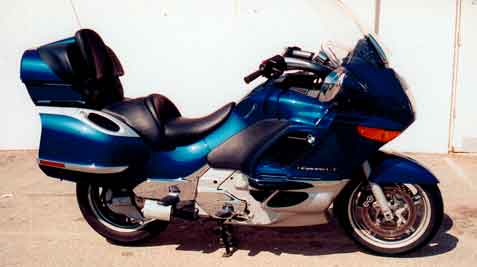
High Static Compression, Overlap, Cams and Pistons
Cold cranking pressures on the RS and LT are very high due to the 10.8:1 pistons on the LT, and 11.5:1 on the RS. Camshafts on the RS have about .050" more lift than do the ones on the LT model. If you look at BMW's published cam timing specs on both models, the cams have zero to negative overlap (only 2 degrees on the RS and -4 degrees on the LT!) Some overlap is required to cool the exhaust valve and to allow the engine to deal with the higher volumes of airflow. Lobe centers on the LT model are spread further apart, shortening the overlap period and thus keeping the cold cranking pressures similar to the RS model. BMW publishes their figures at 3mm (.118 inches) of valve lift which is more than twice the industry standard of .050 inches lift for both opening and closing events.
When we measure the K1200RS using the standard industry figure of .050 inches for closing and opening events the picture changes somewhat. Instead of two degrees of overlap, the figure changes to 27 degrees of overlap. The duration on the cams goes up from 210 degrees to 234 degrees and the new lobe centers sit at approximately 103 degrees on both inlet and exhaust. These are not ideal figures for turbos but they are livable. We would like to see more duration which would allow us to push the lobe centers out somewhat without losing overlap. We are working on camshafts to do exactly that.
We also have had forged turbo pistons made that will replace the stock pressure cast pistons for those of you who want to run elevated (15 to 24 psi) boost levels. These pistons will feature pinned rings for the same oil control as on the stock bikes. This will allow higher boost with increased safety. If you are thinking of worst case scenarios, we have arranged for Nikasil cylinder repair should the unforseen happen...You won't have to worry about completely replacing the block! In case you were wondering about the pistons we used in the 206mph, 312hp, 980cc K100's...they were forged, not stock...and no, we did not run stock cams or stock timing. Pistons are available in standard, higher (non-turbo applications) and lower compression models.
Panels off, Turbo, cannister and connector pipe shown
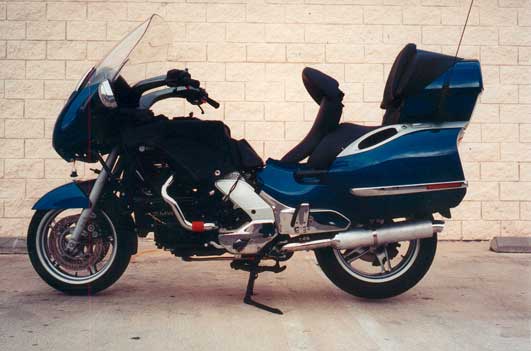
Both bikes' driveability is stock and ground clearance is completely unaffected. Serviceabilty is uncompromised and clearance between the exhaust cannister and the luggage on both models is better than stock. The chrome cover on the LT exhaust can be reused (see top photo). Noise levels are slightly above stock and decidedly pleasant at touring speeds. These are very complicated motorcycles, and although this can be an advantage, it has made engineering the turbocharger systems quite a challenge. There will be two turbo choices for both models ranging from 200 to 300 plus horsepower. Normally the LT model is set for a maximum of 180hp at 15 psi with a smaller turbo whereas the RS model has the larger turbo rated at 255 hp at 15 psi.
Instrumentation for both models is standard with EGT (Exhaust Gas Temperature), RSR Air Fuel Ratio, and Vacuum/Boost. On the K1200LT these three gauges mount on the center dash "pod" just above the stereo controls. The turbo occupies the area formerly occupied by the exhaust system / catalytic converter. The turbo itself is supported by a triangulated steel mount independent from the 4 into 2 into one exhaust header. The RB Racing Boost Guard wastegate (hidden behind the passenger footrest) is dash adjustable and dumps into the cannister exhaust effectively muffling the wastegate as it controls the exhaust pressure. We have used both chrome and ceramic finishes...there may be some choices in this area. The exhaust pictured on the LT is chromed with a brushed aluminum cannister. Production parts are ceramic coated with a black cannister (see photos above).
No, that's not an exhaust system!

With the turbocharger underneath the bike it was quite a problem to fit an air cleaner assembly. On the K1200RS we managed to get the air cleaner on the left side of the bike into a cavity above the exhaust cannister. On the K1200LT model there is no room to do this so we created a right side air cleaner assembly. The filter is the same K&N filter we use on our 350hp Suzukis and 425hp Kawasaki turbos. On both the RS and LT models both center and side stands function normally.
K1200LT Weak Point
Right now the clutch is the weak link. We are working on heavy duty clutches that will need to be installed with the turbo kit. We are hearing of short clutch life in stock bikes and our own testing has shown the clutch will slip quite eaily if it is not fully engaged under low boost shifts.
Turbos are available for the early K100 series. We will be doing a few of these at RB Racing to update oiling systems, wastegates and instrumentation. These kits feature the later design split intercooler and stainless steel 4-1 turbo manifold. Fuel control is via our RSR AIC400 additional injector controller. Kits are available for fifth injector operation with the oem air box or with four additional injectors located in a new inlet plenum. Power is rated at 180 hp @ 15 psi.
Turbos for the first of the 4 valve inline fours are available in two models: 180 hp @ 15 psi and 255 hp @ 15 psi. These kits are receiving newer, updated oil scavenge systems, more instrumentation and revised Boost Master wastegates.
We made a lot of the draw through carbureted kits in the early 80's. This is something we do not wish to revisit as technology has progressed since then. A complete review of these early bikes is being undertaken and we feel that some new innovative designs will give life to the older boxers. Maybe you remember the Futuro.
A complete revamping of our "Oilhead" series of turbo systems is about finished. R1100RT turbos are in production and the R1100S model is in final testing . Turbos and intercoolers for these models are in stock. Lots of parts. Complex critters. R1100RT Turbo part pictured above.
Previous R1100RS turbos were quite spectacular, beating full race (privateer) Ducatis in Magazine sponsored impromptu road races at Willow Springs as well as running 10.6 second quarter miles at 132mph. We have higher goals for the newer models. Photos of these models (GS/RT/R/C) will be posted along with detailed specifications. 1200C models will follow. We have newer turbos than we used in 1993.
We redesigned these systems six times to account for RT fairings, R1100S raised tail models, twice because of changes in turbos, and three times because we ran into a couple of idiots who neglected to pay for things. Life does get complicated.
For those working on R1100RT/RS; R850/1100GS/1100R bikes a pdf workshop manual.
Rocket Fuel
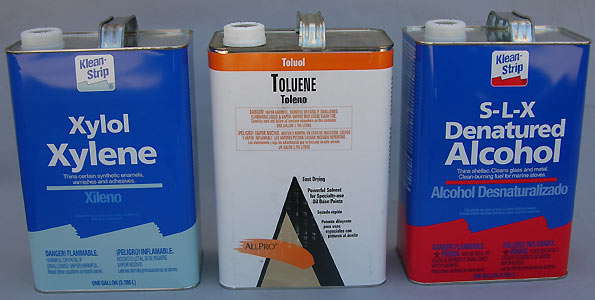
When Honda was spending 500 millions dollars a year on their V6 Formula 1 Turbo motors they ran a mixture containing 84% Toluene (114 Octane). It has excellent anti-detonation properties and increases your octane rating. If you are running 92 octane pump gasoline and you add this stuff, your octane rating will be changed by the formula:
[(Quarts Gas x 92) + (Quarts Toluene x 114)] / (Quarts Gasoline + Quarts Toluene).
For example, if you add one quart Toluene to four gallons of gasoline, your Octane will increase one point from 92 to 93. Add two quarts to four gallons and you get an Octane rating of 100. For you high boost junkies this is something to ponder. You can buy the product in hardware stores. Xylene has a higher flashpoint (less volatile) and has and octane rating of 117.
Denatured alcohol or methanol can be added in a 50/50 mix in our water injection systems.
New Cloisonne Tags
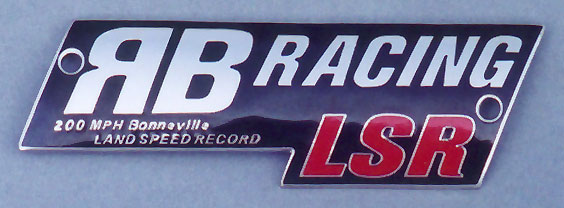
Like in the adage "The relentless search for perfection" we have upgraded the logos we put on our LSR Exhaust Systems. Previous tags were stamped and formed aluminum with silkscreened details. The new cloisonne tags are a precision die struck brass, nickel plated, with powdered glass fired in an oven then polished to a jewelry finish. These are direct replacements for our older tags and are available for US $20.00 via US Global Express (foreign) or Priority Mail (domestic US). They come with black headed rivets and are riveted in place with a light coat of high temperature silicone (Permatex 598B) behind the tag.
We have posted a Quicktime video of the K1200RS Turbo on our Cinema page. There is no lack of power even at the minimum wastegate setting of 5 psi.
Customers
Harley Customer: "How much is it"..."Here's the money"...."Thanks it works great!"
BMW Customer: "How much does it weigh?".... "Will it void my warranty? "If I bring my bike to you, will you install it for free while I wait ?"... "I don't want to pay shipping"..."Do you have any used ones around that I can try?". "My dealer charges too much money, will you do it for less?".
Not all, but it happens often enough. Some people go through life happy and participate, others just...whatever.
Reality Check
This may be your hobby but it is our business and in a business sense, turbos make little sense. That we choose to do them is our choice and it has nothing to do with money. The R&D and the tooling and the testing is money that you never get back...Never! Never! Never! No one appreciates what you do and almost no one understands what is involved. We have done enough free work and R&D to pay for a mansion in Beverly Hills. It is our choice. Got to love turbos if you want to play with them.
We get calls from people who want to know if the exhaust they have will work with the turbo (think about it). We have people who call and tell us they will be happy with 200hp all the time (?). We have people call and tell us they are coming by for an installation...they don't ask, they just announce it. We tell them no and they tell us we are assholes. Got to love turbos if you want to play with them.
We have worked with a number of customers on prototypes over the years. Several have announced they were not going to pay us any money because "RB Racing" was going to get rich off the prototype. We offered any of these people to simply pay us for our time and parts and we'll let them have the business. For some reason they always decline the offer. Something about them getting their regular paycheck without any risk or investment. Every day the clock ticks on and the expenses rise. Got to love turbos if you want to play with them.
Over 600 BMW turbos and 1500 turbos for more than 25 platforms over the years. Thousands and thousands of man hours and hundreds of thousands of dollars invested. Computer code, flow benches, test equipment, custom software, electronic circuitry design, specialized castings, cnc and manual machinery, fixtures, specialized fabrication and welding equiment, training of employees etc etc. Got to love turbos if you want to play with them.
Be prepared. This is serious stuff. Know your responsibility. These aren't phony carbon fiber tank protectors. We love them and hope you do too.
People and Their Toys
After more than 29 years of turbocharging motorcycles we have come to the conclusion that people, for the most part, will never understand what it is that goes into preparing turbocharger systems. If it is something that you are interested in we will be glad to take this 39 years of experience and thousands of hours of time and build some very nice parts. If you are not prepared to pay our price or, if you have any special conditions, simply do not call us in the first place. We have met a few people that we inadvertently "let in the door" who suddenly forgot everything we said and started trying to run the show.
It is not going to happen. Like the batter at the plate who gets hit by the first two pitches, we aren't going to give the pitcher a third chance. If you own your own business you will understand. If you are a 9-5 person with a serious hobby you will never understand.